
18 questions about building and scaling culture - answered!

Written by
Joris Luijke, Co-Founder & Co-CEO
Every company culture is unique, though it can sometimes be hard to describe exactly what sets your company's culture apart from another. You might wonder, when is the right time to define a company's culture? Or, how do you formalize company values? How do I get senior leadership on board?
During our webinar, Secrets of creating and scaling values & culture attendees had questions just like these, and more.
In the interest of providing the most support to all of you who attended, and those of you who couldn't make it but still wonder about these questions - I'm happy to share the answers to many of your questions. All submitted questions from webinar attendees were considered, and some were grouped or consolidated.
We've divided up this Q and A into sections related to:
- Company values and culture creation
- Scaling culture and values
- Company culture and remote work
- Company culture and CEOs or Leadership
We hope that these answers provide you support in building and scaling your company's culture. You can also check out our Ultimate Guide to Creating Company Values for even more on this topic and use our Company Values Strength Assessment to help you finalize values that will more effectively guide your company and people. Here we go!
Company values and culture creation
1. At what stage should a company start defining and communicating culture?
You can start very early in your company journey - but I’d say, wait 2 - 3 years until some of the early team behaviors have started to form. As a guide, I think it’s good to wait until your team gets close to 20 people.
Why?
Values should be part of the existing company DNA to a large extent. If you make up values you currently don't live, they are probably not the right ones. For example, an Atlassian value like "Open Company, No Bullshit" were words picked from conversations folks had already been using - and had been a company philosophy for some time even though it hadn't been articulated.
2. What are the steps to formalizing and defining company values?
We created a list of 8 rules to develop a framework for a great value and a calculator to check how ‘strong’ your company values are. Feel free to access Pyn's Values strength assessment here!
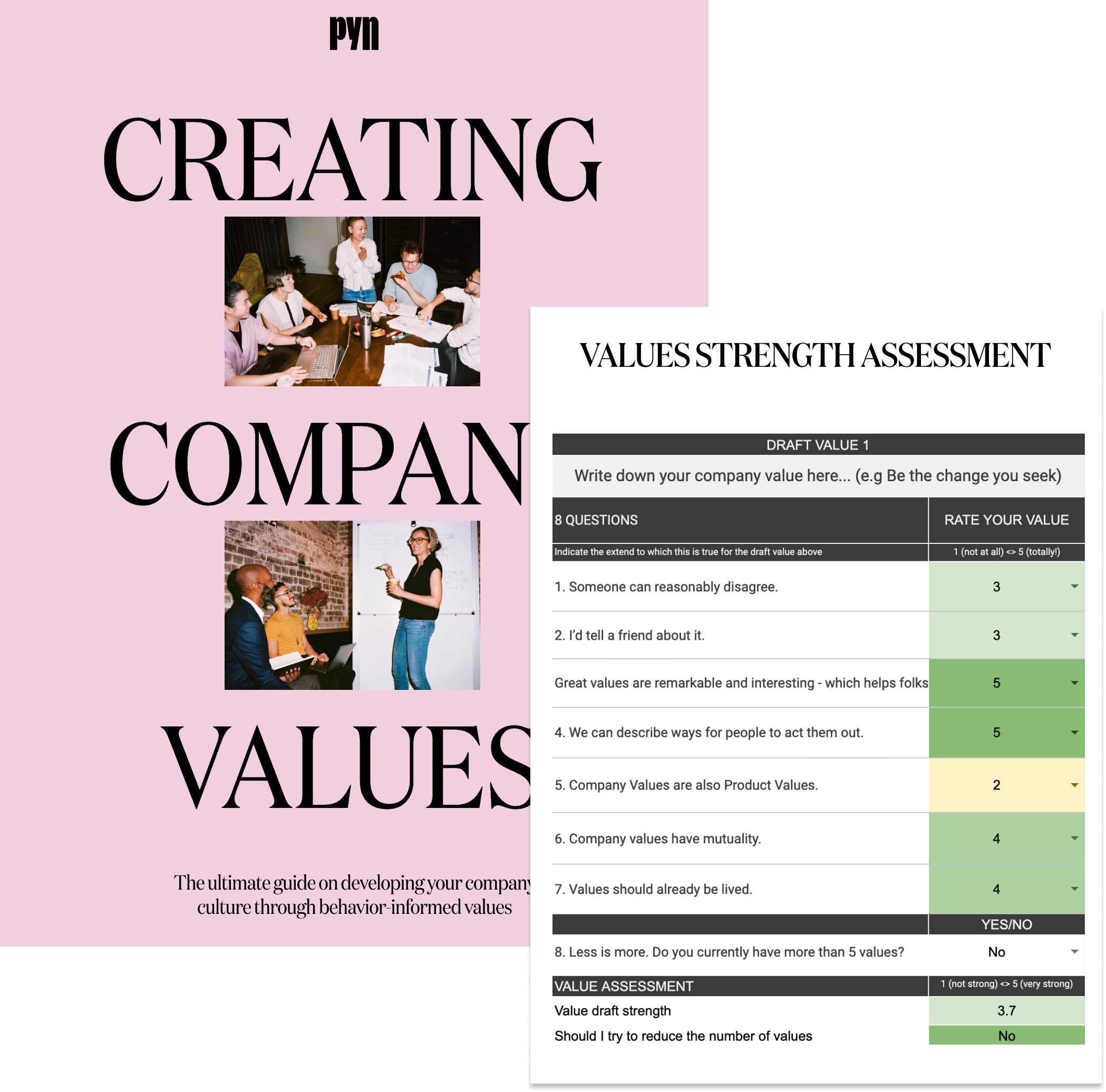
3. How do I create a company culture?
It’s best to start with a more practical and measurable way to describe company culture.
If you go online, you’ll find many ‘definitions’ of company culture. Definitions like “A set of shared values, goals, attitudes and practices that characterize an organization” or, “What happens when the boss is away.” Regardless of definition, the common thread is that company culture reflects the behaviors of our people.
I found that a more actionable and measurable way to define culture is by describing it as follows:
If a majority of people behave a certain way a majority of the time then that behavior is part of your culture. (So, if two thirds of your employees are having lunch together two thirds of the time - you have a culture of having lunch together).
Get more people to do something more often and you can impact culture. How to do that is explained in the second part of our guide on company values.
4. What should be taken into consideration in building out a culture where there seems to be none?
Every company has a culture, though it may not have been articulated yet. You may find it boring or uninspiring though.
You can start small. Try writing down the most interesting rituals or processes in the company in one document and ask folks to comment on it. You can make that document part of your onboarding process, so new hires know what to expect.
Putting together company values could be a great next step. They play an important role in scaling culture as they can provide behavioral guiding lights on how to deal with any situation.
Scaling culture and values
5. As the organization evolves, how should values evolve?
Your company culture will definitely change, but don’t evolve your values (or at least not too much). To explain, let me share the story of our growing family.
My partner and I just had a baby. He is very sweet, but we realize our family culture has changed completely. Where used to have a culture of sleeping in on weekends. Now we have a culture of getting out of bed at 7am - - every day! Baby = new culture.
So, how do we keep our family together? And, what keeps your company special as you grow?
The most important thing is that my partner and I hold similar values. We both like politics and social justice issues. We both need to stay creative.
It is those shared values that will keep us together, even when our culture changes. (And perhaps we will instill some of those values on our little baby when he grows up).
This is why it is so very important to write down your company values and to not change them, or at least not too much. In all companies I personally worked for - the values have stayed exactly the same, or some minor tweaks were made (one of the values was changed out). If you do, make sure you re-introduce it to the company.
6. How do you put an emphasis on culture when the company is rapidly growing?
This question is pretty much the challenge Pyn set out to answer. And I think we are doing a pretty good job at helping our customers like Everquote and Lucid solve it.
Two decades into SaaS, nearly every customer-facing category has myriad tools that power creating, sending, and analyzing everything from customer marketing collateral to customer support interactions. These tools have transformed the go-to-market motion, enabling companies to bring their products to market with messaging that is personalized and on-demand.
But there’s not been a similar evolution in the way companies communicate with an arguably more important stakeholder at their business – their own employees.
Pyn is an employee experience platform people teams use for personalized communications to a target group of employees, at just the right time. If you run HR and are responsible for the Employee Experience you’ll want to proactively nudge, support or guide your people. That’s relatively easy when you are 50 people, but endlessly harder at scale.
Pyn solves this scaling challenge. Pyn tracks events that people experience and automatically sends them helpful information. For example, if you’ve just been promoted to people manager - you will receive a Slack with information on how to successfully run your first 1:1 with reports.
It’s personalized employee communication that can make a big impact on productivity, development, and culture.
7. How do you transform values into behaviors?
Firstly, is to simply list all values and (behavioral) descriptions in ways for people to act them out. I thought Gitlab did this pretty well in their handbook, in which they use the term Sub-Value, where "sub" doesn’t refer to "subordinate," but rather, "substantiate the core values - to clarify what a given core value means at their company behaviorally.
Secondly, tell stories. Scaling company values, starts with introducing them to new people who join your organization.
Every hire, regardless of position or location, should learn and understand the company values.
New hires are generally very open to new information in those very early days (before their calendars are being filled with meetings and projects). So, they’ll be more likely to read that story of an employee living the values (storytelling works great!) or watch a video explaining how the values relate to the day to day job.
How do you link company values to daily practice, so they are tangible for everyone?
You can't manage everyone’s behaviors all the time. But you can certainly encourage people live your values at the moments when it matters most.
Throughout the employee journey, there are certain moments where behaviors can have an outsized impact on the culture you want to create or reinforce. Guiding behaviors during those moments is crucial if you want to scale culture. Some of those moments include:
- Life moments: birth of child or a return from long term illness
- Transition moments: moving teams or promotions
- Crisis moments: layoffs or a security break
- Cyclical moments: rituals around salary reviews or goal setting
- Organizational moments: moving to remote or a reorg
Forward thinking People Teams are mapping these moments out as part of the Employee Journey - a visual representation of an employee's experiences in your company across all important moments.
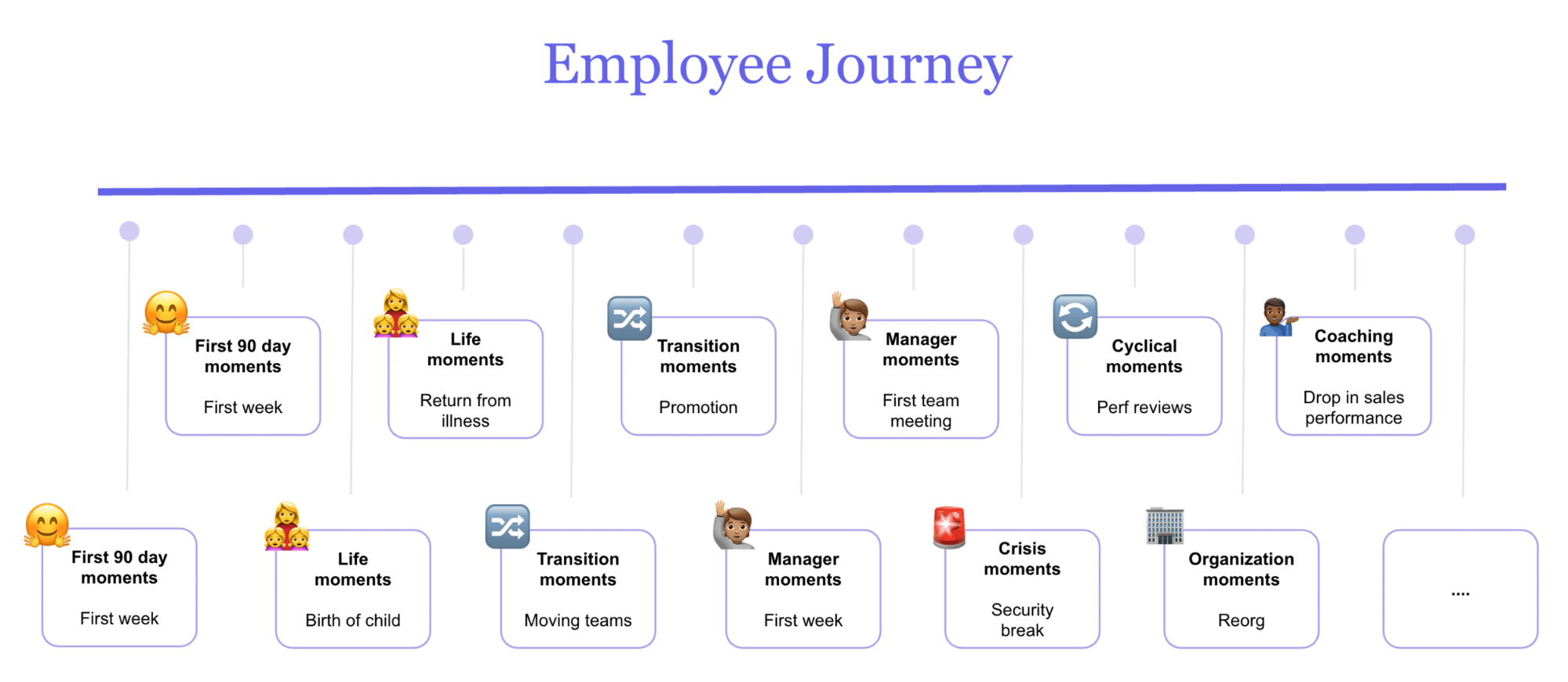
Check out an example Employee Journey Map here
There are new ways to guide employees through those moments allowing companies to instill behaviors in employees and managers that are in line with the culture the company aspires to build or maintain.
Software like Pyn allows companies to automatically send employees highly personalized guidance at moments that matter most.
8. How can we train people on behaviors and make them stick?
There are plenty of opportunities to remind people of the company values.
You may reinforce your values or important behaviors in common people practices where people’s behaviors are under the spotlight, including for example recurring performance reviews.
Modern tools and smart practices can reinforce the behaviors you want to see more off. Here's some common techniques:
1. Timely
People are much more likely to respond to a behavioral nudge when the message is relevant to what they’re currently experiencing, for example, it’s much easier to instill certain manager behaviors in the weeks following a promotion to manager. It’s a lot easier to help a manager show their people care if you send the manager a nudge just before someone’s anniversary.
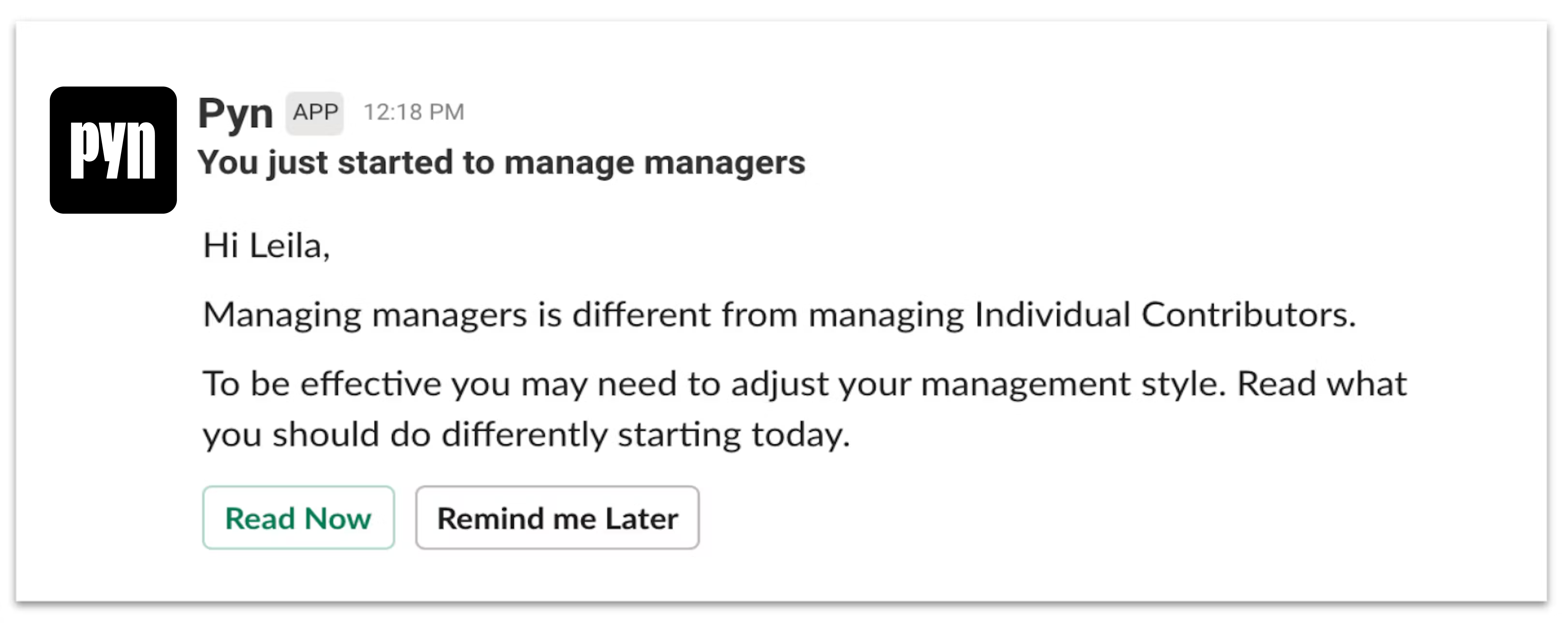
2. Ease
Make it super easy to do something or act a certain way.
Of course you can educate your employees the importance of recycling, but putting a large paper bin next to a copy machine works better in changing behaviors. Cause it’s easy!
We put a lot of focus on explaining why we want people to do something that we forget about making really easy.
Remove any friction and make it easier to do something right then to do it any other way

Putting a message in the person’s own contextual setting will make them more likely to act. We have a lot of data about our employees that we can use to do this. So, instead of sending the same message to all new managers, use that data to send a more relevant and personal message.
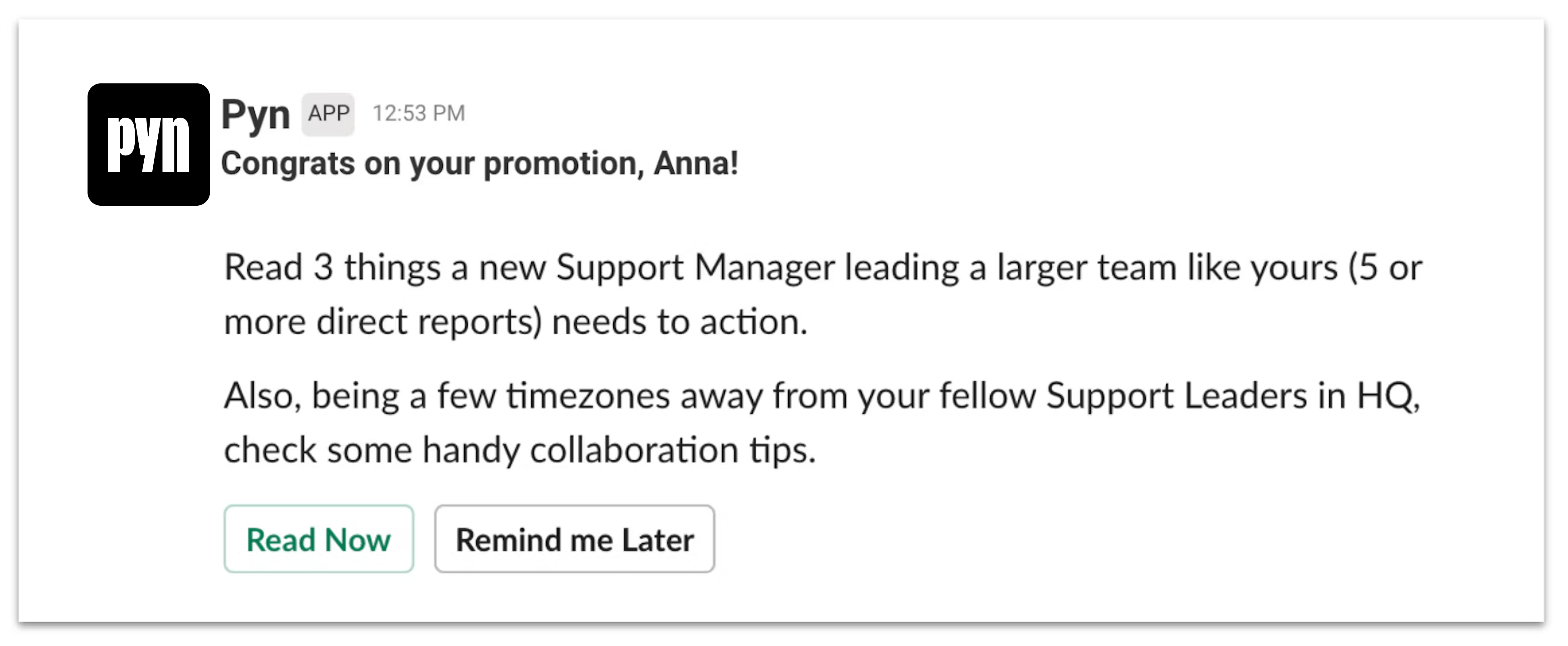
9. How do I highlight good behavior being rewarded?
There are plenty of opportunities to celebrate great behaviors.
Many modern People Teams ensure that values feature in common people practices where people’s behaviors are under the spotlight, including for example practices like peer-to-peer recognition.
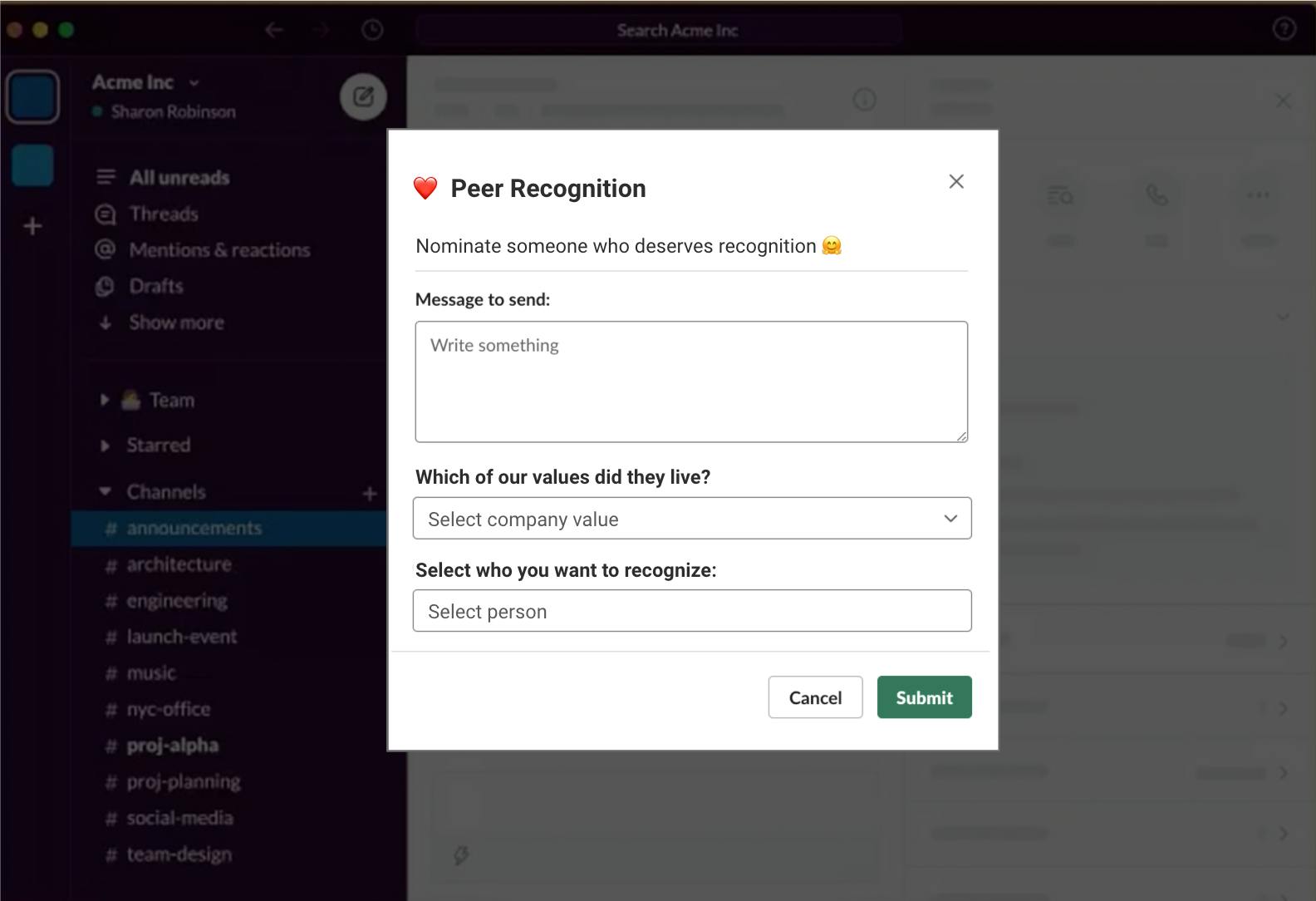
Company culture and remote work
10. How do you create an equitable onboarding experience for remote employees?
A few things companies found work well, from fully remote teams (like Buffer or Gitlab) to newly hybrid companies. What it comes down to is to do onboarding like you would in-person, but to do it properly - really(!) with a lot more structure and support.
Avoid information overload
It’s not always just sharing what folks need to know — getting the timing right is equally important. Remote onboarding in particular is a delicate timeline of tasks and syncs to convey all of the proper information.
Don’t give a new hire a long task list. Spread out information over a few weeks. Really, they don’t need to know all policies week 1.
Implement an Onboarding Buddy Program
I admit not being a big onboarding buddy-program fan in my earlier HR career. But buddy programs work, especially for remote teams!
Not only does an onboarding buddy program boost productivity (Microsoft measured the effects of their internal program: 56% of new hires who met with their onboarding buddy at least once in their first 90 days said it made them more productive. That percentage increased to 73% for those who met their buddy 2-3, 86% for those who met 8x, and 97% for those who met 9x).
It also made new hires happier (Again, Microsoft’s internal research found that after their first week on the job, new hires with buddies were 23% more satisfied with their overall onboarding experience compared to those without buddies. This trend continued at 90 days with a 36% increase in satisfaction.
Check out our guide on building an onboarding buddy program that doesn't suck
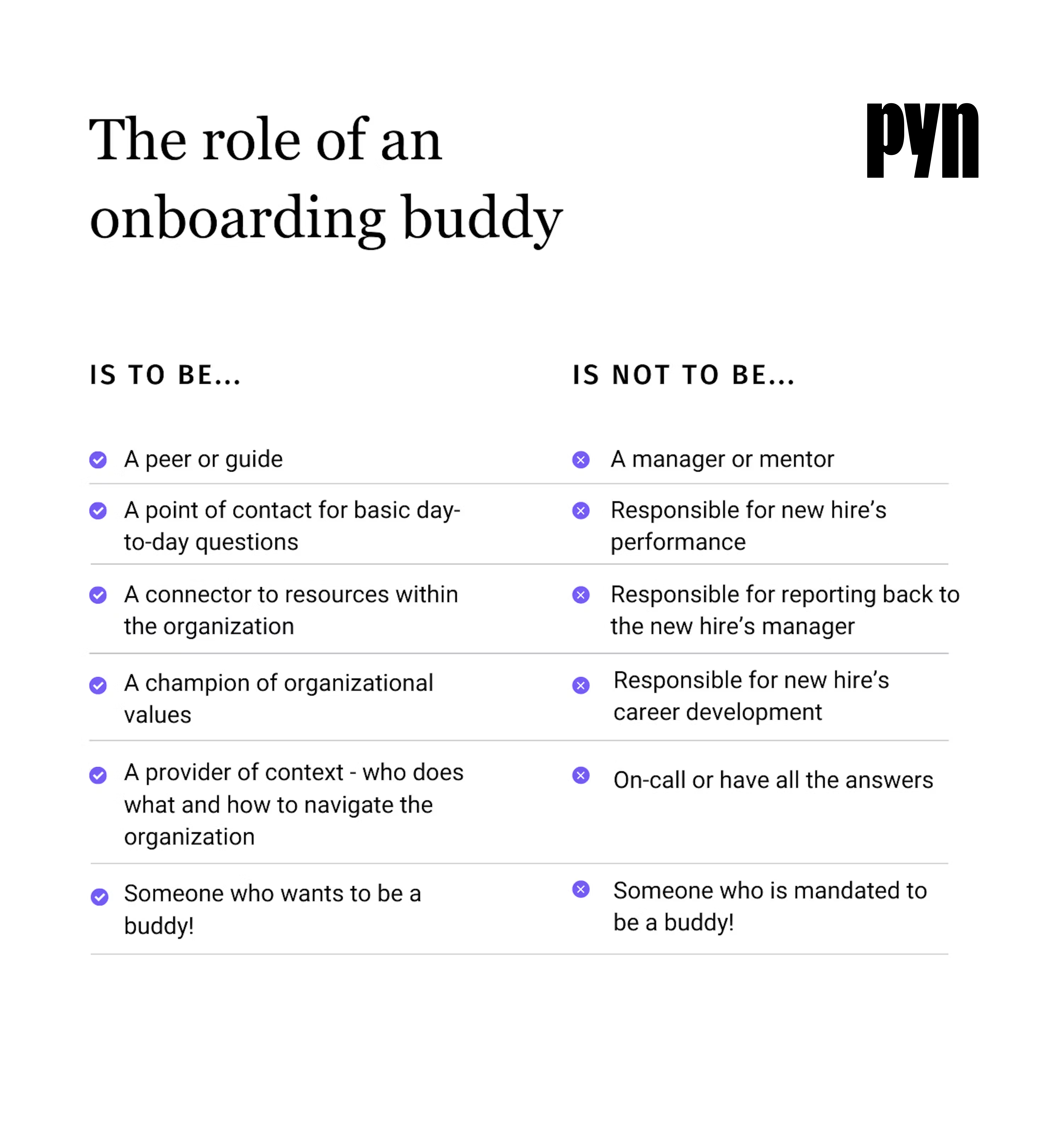
If you still use the same planning docs that you used pre-pandemic, you probably don’t provide enough structure. When planning the first month for your new hire, you need to give your managers the tools to create more detailed goals. If you don’t use one already, I’d suggest giving the manager a 60 day plan template (I feel 90 days is a bit long for fast moving tech companies).
Celebrate success early and publicly
When we’re in the office together, compliments and smiles are more frequent.
You want your new hire to be motivated and confident, and you want the team (and perhaps other teams) to be excited about your new hire. That’s why it’s important to help your new hire get an early win. Early wins excite and energize people and help build their personal credibility.
Then, make sure their manager or skip-manager praises them for their work during a team meeting or other meetings. It builds your new hire’s confidence and motivation and will help establish their credibility within the wider distributed team.
11. What are some best practices to minimize efforts being viewed as just an HR initiative?
I agree with the sentiment in this question. Culture shouldn't be a one off HR initiative, .. it’s about a systematic approach to ensuring folks behave in a way that contributes to the culture you want.
A more strategic approach = an employee experience approach.
Map out the Employee Journey - a visual representation of an employee's experiences in your company across all important moments. And ensure people have the right information and guidance to be their best selves at the moments that matter. This includes managers, employees, executives - everyone!
12. How do we ensure our values and culture are shared amongst employees in a remote setting?
It’s one thing to create values. It’s another to have every employee living by those values. In our Ultimate Guide to Company Values we cover more common HR practices to “introduce” and “reinforce” values and dive deeper in newer techniques used by people teams to ensure people act accordingly with values especially at times it matters most.
Scaling company values starts with introducing them to new people who join your organization. Every hire, regardless of position or location, should learn and understand the company values. New hires are generally very open to new information in those very early days (before their calendars are being filled with meetings and projects). So, they’ll be more likely to read that story of an employee living the values (storytelling works great!) or watch a video explaining how the values relate to the day to day job.
13. How can we build a sense of belonging throughout teams when working remotely?
Remote work can be isolating and tough sometimes. Family circumstances, local events, even a blocked toilet… In a way, having a separate “home space” and “office space” made things a little less complex. Sometimes people just need someone to listen and emphasize.
It’s especially important now for leaders to be sympathetic to what’s going on in a person’s personal environment. Companies that create a sense of belonging give their managers the tools to do this. And, as leadership team - make sure you don’t put off that company engagement survey! Try out these other tips:
1. Start team meetings with social networking
We start every larger meeting with a quick temperature check. Other companies may have a 10-minute section with some fun ice-breaker style questions. It helps feel like we’re connected as humans (as well as coworkers).
2. Transparency is even more important
Newly remote workers are often surprised by the added time and effort needed to locate information from coworkers or about company processes. Even getting context and answers to what seem like simple questions can feel like a large obstacle to someone working remote.
Transparency not only gives people more context which helps them find their way around quicker, it also makes remote employees feel connected to the company and wider team. Ensure you give even more context to help your team understand why you made a decision.
3. Give folks (more) opportunity to give feedback and contribute
Ask people for feedback on the team agenda items. Survey your team more often. Encourage your leaders to do more regular free flowing AMA (Ask Me Anything) sessions.
4. Ask your managers to extend their 1:1s by 10 minutes and start with “temperature checks”
Getting to know and staying connected to a remote employee on a personal level takes additional effort. You can slack and email back and forth about work updates all day, but that precious time we have to connect over video is rarer. Start with connection first.
Use the first few minutes to talk about non-work related topics (weekend plans, kids, pets, or last night’s big game) -- something fun and light-hearted and more personal. This will help you build trust and rapport which is necessary across all relationships, but especially remote ones.
It’s also important to ask a simple and often overlooked question: “how are you feeling”? (Note: asking “how are you?” might elicit just a short response”). Being specific is key.
Company Culture and CEOs or Leadership
14. How do you convince upper management that it’s worth the time and effort to define company values?
Alignment on what you want to accomplish at work (mission, goals) and the way you get the work done (behaviors, values, processes) have a measurable impact on business success. This study, for example, shows that brands with a strong purpose and direction grew 175% in value over a 12-year period (compared to 86% median growth rate for other businesses).
And from my own experiences running HR at companies like Atlassian and Squarespace I can attest to the power of integrating the values with the strategy, mission, and goals. There is a stronger sense of belonging and more clarity when decisions need to be made. The latter is perhaps even more valuable for more remote companies, like the fully remote company Gitlab. In their handbook they explain how their values serve as their universal north star, aligning team members on how to address challenges or disagreements.
In any environment, and particularly in an all-remote or distributed setting with people across multiple time zones as the company's values will lead to less ambiguity in decision making.
In short, it makes good business sense!
15. How do you get leaders to buy into values?
Get them involved in the creation process, or in the translation process. And, like with anyone, recognizing the values they live naturally as an individual helps cement the values even further.
Creation
There are several ways to “workshop” the values creation process.
One exercise that stuck with me was the process at Atlassian. Early on, the company did their version of Jim Collins’ “The Mars Group” exercise, which asks companies to “Imagine you’ve been asked to recreate the very best attributes of your organization on another planet.” A group of 12 people were selected from across different teams.
But alongside this group company leaders worked in parallel. The executive team created their one values lists separately, and integrate the two lists later.
Translation
Not every leader will be involved in the creation process. But they have a big role to play in the ‘translation process’ - helping the company values makes sense in their day-to-day setting.
Ask the leaders questions like:
- How are these values lived in my team (stories / examples)
- How would you be able to interview for these behaviors in our team (recruiting)
Recognition
Just like they would do for their team, one of the best ways to motivate your leaders to live the values is to recognize positive examples of leaders who have demonstrated them. If the executive team regularly shares ways that their leaders have put core values into action will help them to do the same for others in their teams!
16. How do you hold management accountable for shaping culture?
What gets measured gets done, right? Though ‘culture’ may seem less measurable - it’s actually not that hard. Four ways:
1. Survey
It is best practice to ask your people about the company culture and values. Your regular engagement survey works fine. Use survey questions to understand the team culture and check if your communication strategy has effectively articulated them.
Then it’s best to compare the survey results between departments and coach department heads to improve scores in areas they are lagging behind.
2. Performance Reviews
Hold your leaders accountable with the same methods that they hold their employees accountable. For example, if you use performance reviews, provide your leader feedback on how they live the values. It makes it clear that that is important for everyone in the company, regardless of position.
3. Process expectations
Make expectation crystal clear in terms of what processes you’d expect values to be showcased or measured. E.g. you may expect your leaders to incorporate values as part of their recruiting and onboarding process. How prescriptive you are on “how” they will incorporate the values in their departmental processes will vary from company to company.
4. Encourage peer to peer feedback
Encouraging feedback between managers to create a more open environment. Encourage your managers to give each other feedback when they notice behaviors or processes that are not in line with company values. Managers may not always be aware that their approach hinders the desired culture unless it is pointed out to them by a peer..
17. How do you decide on values with indecisive leaders?
Implement a ‘Soaking period’.
When you implement values for the first time, there is no harm in defining and communicating values and telling everyone that you may do some tweaks to the values after 6 months. This ‘soaking period’ gives everyone the opportunity to get used to the new values and gives indecisive leaders the comfort that changes could still be made if needed.
This time also gives you or the founders the opportunity to tweak the wording and assemble examples and stories of people living the values - which generally creates more excitement.
Note, during the 6 months period, ensure you do start reinforcing the values internally in programs like recognition, performance reviews, onboarding and more.

Joris dreamt of having Pyn as Head of People at Atlassian and Squarespace. Now dreams of getting a sleep-in on Sunday.
